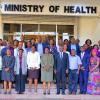Micronutrient Technical Working Group Reviews Fortification Standards for Key Food Vehicles
Kampala, Uganda – 15th May 2025.
NHLDS reaffirmed its commitment to addressing micronutrient deficiencies through coordinated national efforts. This was during the quarterly micronutrient technical working group meeting hosted at the NHLDS premises located in Butabika.
During the meeting, experts reviewed the proposed amendments to the fortification specifications for key food vehicles, including Fortified wheat flour (EAS 767: 2019), Fortified maize products (EAS 768: 2019), Food fortification premix and fortificants (EAS 1023: 2021), and Fortified composite flour (EAS 1024: 2021).
It also reviewed the progress of the MicroNuT-IPHL project, which aims to establish in-country laboratory capacity for assessing micronutrients and food safety biomarkers. This is a critical initiative that utilizes cost-effective surveillance models to generate routine data for monitoring the impact of nutrition interventions.
The Micronutrient TWG meeting, chaired by the Nutrition Division of the Ministry of Health, brings together key stakeholders to advance Uganda’s micronutrient intervention agenda, which includes behaviour change communication, micronutrient supplementation, and food fortification. These efforts are crucial in preventing and managing conditions caused by micronutrient deficiencies, particularly among vulnerable populations.
Uganda's micronutrient programming is coordinated through the Micronutrient Technical Working Group and the National Working Group on Food Fortification (NWGFF). These bodies play a central role in aligning national standards with international best practices and regional guidelines. The program is expected to generate actionable insights that will shape future policy directions and strengthen Uganda’s capacity to combat hidden hunger through food-based solutions.




